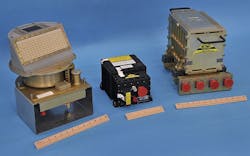Army orders as many as 94 lightweight synthetic-aperture radar systems for surveillance UAVs
Officials of the Army Contracting Command at Aberdeen Proving Ground, Md., announced a $40.7 million contract to Northrop Grumman on Wednesday for as many as 94 AN/ZPY-1 Small Tactical Radar-Lightweight, otherwise known as STARLite.
The contract calls for STARLite radar systems with synthetic aperture radar (SAR) mode, as well as for Ground Moving Target Indicator (GMTI) mode.
The STARLite radar weighs 65 pounds and is designed for tactical reconnaissance applications on manned and unmanned aircraft. The radar offers three modes: SAR, GMTI, and Dismount Moving Target Indicator (DMTI). The system is capable of conducting all-weather, wide area surveillance and detecting stationary targets, people on foot, and moving vehicles.
Army officials are particularly in interested in the STARLite radar for the MQ-1C Gray Eagle UAV, and for the Persistent Threat Detection System (PTDS) aerostat. STARLite is compatible with a standard ground control station.
The radar provides two SAR modes: strip and spot, Northrop Grumman officials say. In Strip mode, the radar imagery either is parallel to the aircraft flight vector or along a specified ground path independent of the aircraft flight path. In Spot mode, the radar produces a high resolution image at a specific geographic patch.
Related: General Atomics wins $110.3 million Army contract to maintain MQ-1C Gray Eagle UAVs
In GMTI mode, the radar provides moving target locations overlaid on a digital map. In DMTI mode, the system tracks the movement of individuals on foot.
For more information contact Northrop Grumman Electronic Systems online atwww.northropgrumman.com, or the Army Contracting Command at Aberdeen Proving Ground at www.acc.army.mil.

